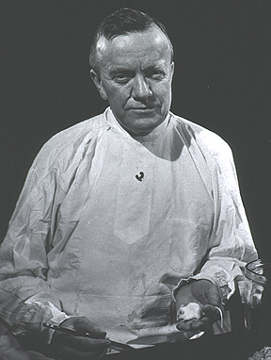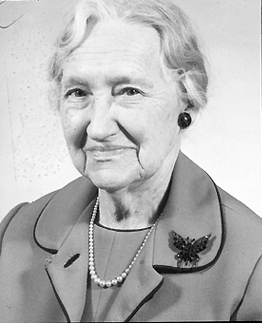Tuesday, September 21, 2004, marks the second annual NIH History Day. This year’s theme—"Scientific Biography"—spotlights how advances in biomedical research depend on individual curiosity, perseverance, and creativity, augmented occasionally by serendipity.
Featured speaker Thomas Söderqvist, professor of the history of medicine and director of the Medical Museion at the University of Copenhagen, will lecture on "The Seven Virtues of Biography, or: What’s the Use of Biographies of Life Scientists?" at 3:00 p.m., September 21, in Lipsett Auditorium, NIH Clinical Center (Building 10). Söderqvist’s most recent book is Science as Autobiography: The Troubled Life of Niels Jerne, a personal and scientific portrait of the 1984 Nobel laureate in physiology or medicine.
The Office of NIH History encourages senior NIH scientists to send in digital or paper copies of their CVs along with photos, both candid and posed, to be added to its biographical reference files. On NIH History Day, collection stations will be staffed in the lobbies of Buildings 10, 50, and 37 for the convenience of scientists who want to donate in person.
For more information or special accommodations, contact Sarah Leavitt by e-mail or at 301-496-8856 or consult the NIH history website.
Following are two biographical sketches that illustrate the theme. Charles Armstrong was the first intramural scientist elected to the National Academy of Sciences, and Margaret Pittman was the first woman to be named chief of an NIH laboratory.
 |
|
Charles
Armstrong
|
CHARLES
ARMSTRONG:
ESTABLISHED A MOUSE
MODEL FOR POLIO
Charles Armstrong (1886-1967), best known for his work on polio, studied many contagious diseases in his years with NIH. Armstrong received his PHS commission in 1916 and made a name for himself conducting studies of disease outbreaks.
His first triumph came in 1920 when he correctly traced the cause of an outbreak of botulism among party-goers in Ohio to tainted olives. This discovery led to a half-million- dollar upheaval of the olive canning industry in California.
Assigned to the Hygienic Laboratory (the predecessor of NIH) in 1921, Armstrong traveled to several locations—among them Haiti and a Navajo reservation—to study epidemics. Attuned to the practical side of public health practice, Armstrong was able to solve several health mysteries.
One important example is the case of usually fatal post-vaccination tetanus in children who had been given smallpox vaccinations. The culprit turned out to be the dressings, often celluloid shields, which harbored the tetanus spores.
His work in the new field of virology led to discoveries of new diseases and strains of diseases–and also led him to contract at least six of the diseases he studied, including psittacosis, encephalitis, and Q fever.
Armstrong’s work in polio research earned him a place in the Hall of Fame of the National Foundation for Infantile Paralysis. He had spent years doing experiments with nose sprays that would temporarily prevent the spread of polio, and, perhaps more importantly, had been able to induce the disease for the first time in mice, thereby providing an affordable animal model that would eventually lead to the development of a vaccine.
Armstrong served
as chief of the Division of Infectious Diseases from 1940 to 1950 and—in
1944—became the first NIH staff member elected to membership in the
National Academy of Sciences. ![]()
 |
|
Margaret
Pittman
|
MARGARET PITTMAN:
VACCINE STANDARDS PIONEER
Margaret Pittman (1901-1995) is best known for her pioneering work in the production, testing, and standardization of vaccines to prevent typhoid, cholera, and pertussis.
In a career that included 35 years with the Division of Biologics Standards (later renamed and transferred to FDA), Pittman traveled to the far reaches of the world in her quest to develop and encourage the use of safe vaccines.
Pittman began her research career in the 1930s at the Rockefeller Institute In New York (now the Rockefeller University), where she studied the microbiology and immunology of infections caused by Haemophilus influenzae. Her discovery—that there were six varieties of the organism, of which only one type caused serious disease in children—eventually led to the development of a vaccine for preschoolers in 1985.
After coming to NIH in 1936, Pittman turned to research on pertussis. This work led her to develop a usable mouse model for the disease in 1944. She then used the information gleaned from the mouse studies to develop a vaccine potency standard. These studies led to the international potency requirement issued by the World Health Organization (WHO) in the 1950s. Pittman was also involved in finding and standardizing vaccines for other diseases and was at the forefront of research in eliminating toxins from vaccines.
She took on administrative duties when she was named NIH’s first female laboratory chief (of the Laboratory of Bacterial Products) in 1958, but continued to work in the field.
In the 1960s, Pittman
was selected to join the Southeast Asia Treaty Organization’s cholera
project and traveled to what was then East Pakistan to help develop standards
for a cholera vaccine. As a WHO consultant in the 1960s and 1970s, Pittman
traveled to Egypt, Iran, and Spain to work out vaccine standards and conduct
field trials. ![]()